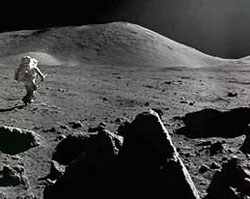Moon landing struck pop cultural chord
 Los Angeles - Since the dawn of time mankind has been fascinated by the mysteries of the universe. But rarely has that allure so dominated popular culture as in the years surrounding the first moon landing, when the exploits of heroic scientists and astronauts were reflected in music, film, print and the national identity of the United States.
Los Angeles - Since the dawn of time mankind has been fascinated by the mysteries of the universe. But rarely has that allure so dominated popular culture as in the years surrounding the first moon landing, when the exploits of heroic scientists and astronauts were reflected in music, film, print and the national identity of the United States.
The hoopla peaked on July 20, 1969, when Neil Armstrong and Buzz Aldrin became the first humans to set foot on the moon as millions of people watched on television in what was the most widely broadcast event in history.
More than 10 years later the image of an astronaut standing in the "magnificent desolation" of the lunar landscape, as Armstrong called it, became the logo of MTV, though the music video channel did swap the American flag with an MTV flag. Executives at the time said they chose the image because it "reflected an undiscovered realm of possibilities and a horizon that would forever be altered."
Coming as the country was riven with controversy over the Vietnam War, the moon landing was celebrated as a non-controversial reflection of the supremacy of the US spirit.
"It was an amazing moment that touched every facet of culture, art and society," history professor Cherie Parris of the University of California said. "From art to architecture, the space race changed the way we looked at the world."
While it marked an undoubted milestone in mankind's understanding of its place in the universe, the successful effort to land a man on the moon also offered many more prosaic benefits. A partial list includes TV satellite dishes, medical imaging devices, the in-ear thermometer, fire-resistant materials, cordless power tools, shock- absorbing materials used in helmets, joystick video game controllers, global positioning devices, food freeze-drying and preservation processes, and communication and weather satellites.
But even before the historic moon landing, the implications of the space race were being questioned. Director Stanley Kubrick released his seminal movie, 2001 Space Odyssey, in 1968. No one has ever deciphered exactly what that cinematic masterpiece was trying to say - but it's clear that it represented a new vision of technology as a powerful and poetic, but dangerous, tool.
Other movies, television shows and pop stars were quick to jump on the space bandwagon. The legendary Star Trek series began in 1966 and merged the twin goals of space exploration and peaceful coexistence with people of different appearances and beliefs.
Another seminal cultural moment sparked by the moon landing was David Bowie's Space Oddity, about a fictional astronaut named Major Tom whose adventure ends in tragedy as he floats away from his spaceship. The song was released on July 1969 to coincide with the moon landing and was used by British broadcaster BBC in its coverage of the event.
Bowie is now re-releasing the song, together with the eight original recording tracks to allow digitally savvy fans to remix their own versions.
That's just one of many products hoping to cash in on the 40th anniversary celebrations.
Cellphone maker Motorola, which made many of the key communications technologies on the lunar mission, is issuing a limited edition version of its top-of-the-line Moto Aura Celestial cellphone, which for the modest price of 2,800 dollars comes with audio and video from the original moon mission, and Apollo 11 wallpapers.
If you really want one, you'll have to go to Bloomingdale's in New York City, which is the only place where they are on sale.
The moon landing was famously characterized as a small step for man and giant leap for mankind - so who better than Nike to capitalize on the celebrations? The company has released the Air Max 1 sneaker, to commemorate the event, with dappled silver leather that's meant to represent the lunar surface.
Arguably, nothing was more important than the images millions of people saw that day - a good enough reason for camera maker Hasselblad to launch a special Space Centre Photo Contest.
"There was this incredible leap in awareness that we got from looking homeward from all that distance and seeing the Earth as a precious and tiny oasis of life in the vastness of space," said Andrew Chaikin, author of the book, A Man on the Moon.
"That is a very profound shift in perspective that Apollo gave us that we still need to absorb. We are still trying to get with the fact that the Earth is a world to be cherished and protected." (dpa)